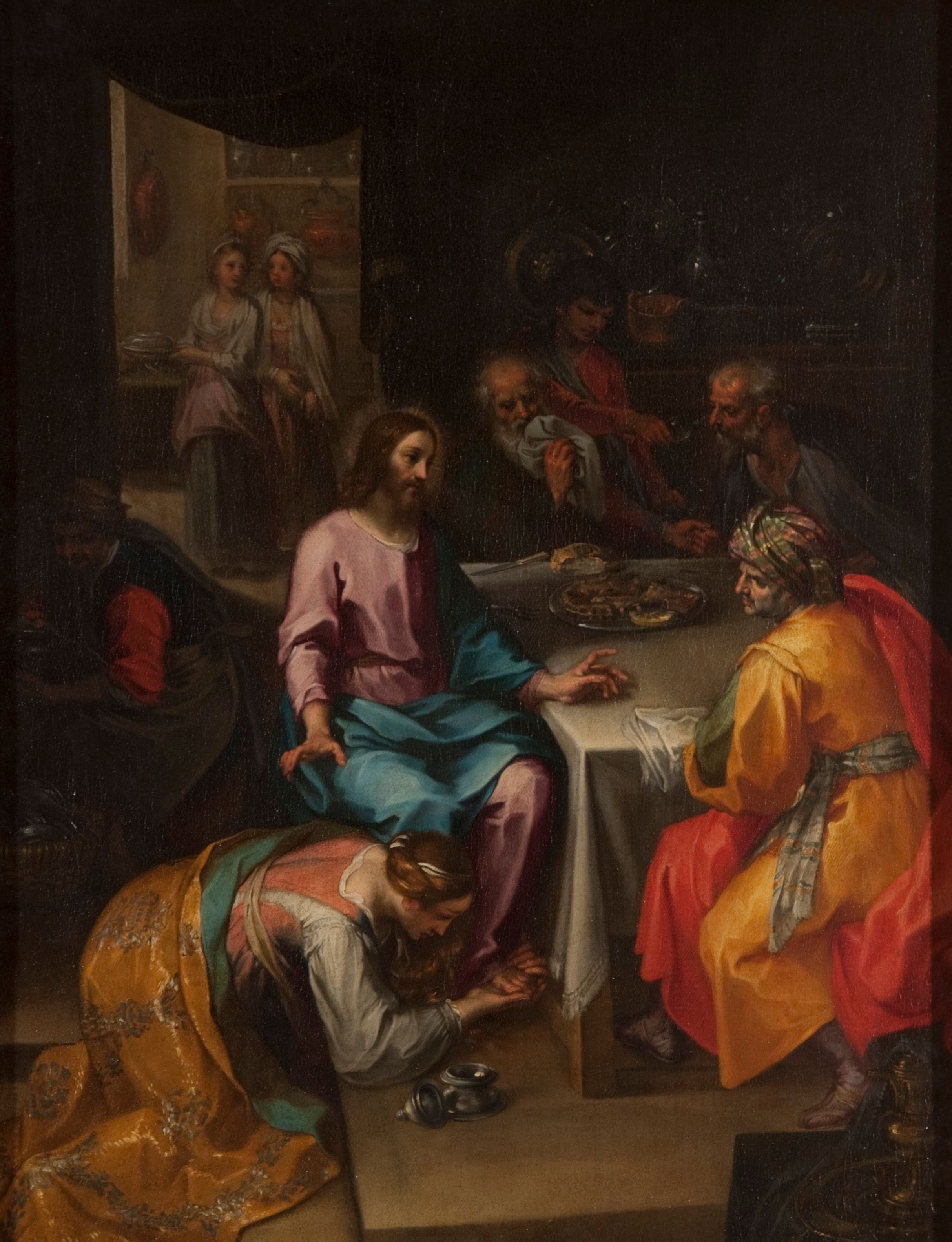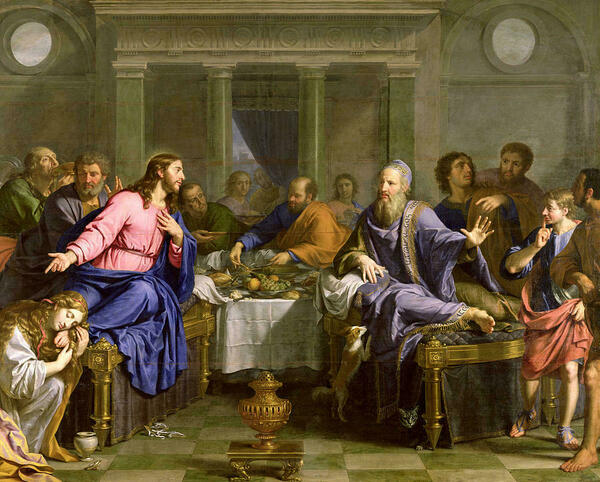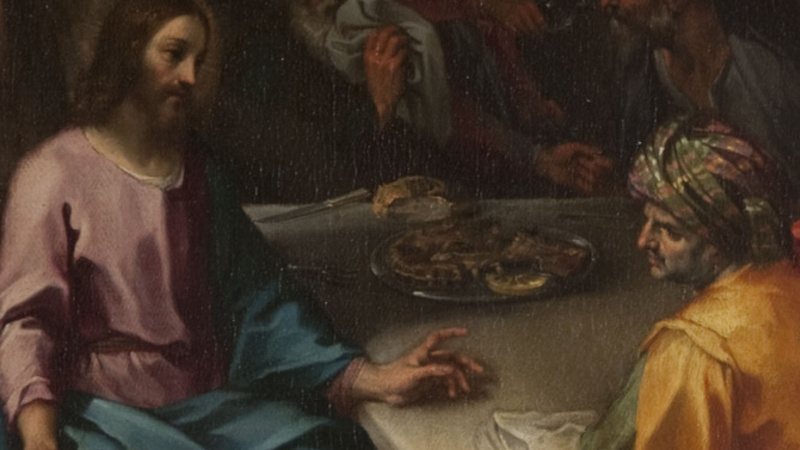At a time of turmoil in the Catholic Church, the Catholic Reformation managed to give rise to artists like Francesco Vanni, who used their faith and artistic talent to reinvent the image of a broken Church. Color, perspective, and symbolism were all tools cleverly used by artists like Francesco Vanni, Annibale Caracci, and Federico Barocci to give new life to Bible stories told throughout time. Still more, it was often the ways in which the artists chose to defamiliarize their works that helped them to effectively reach their viewers. Vanni in particular perceived how society was changing and used his artistic skills to speak to his audience in new and innovative ways.
 Fig. 1. Undefined, Christ in the House of Simon the Pharisee, ca. 1600, oil on canvas. Snite Museum of Art, University of Notre Dame. Gift of Mr. and Mrs. Robert B. Mayer, 1962.007.
Fig. 1. Undefined, Christ in the House of Simon the Pharisee, ca. 1600, oil on canvas. Snite Museum of Art, University of Notre Dame. Gift of Mr. and Mrs. Robert B. Mayer, 1962.007.Specifically, in Christ in the House of Simon the Pharisee (1600) (fig. 1), Francesco Vanni uses domestic life as a medium to express Catholic teaching in a manner that speaks to a lay audience.
Francesco Vanni, though not widely known, was a prominent master of art in sixteenth-century Siena. His art captured not only the events of the world around him but more specifically the core of his life and his identity. Vanni, who was born in 1564 and died in 1610, worked in Siena most of his life; however, flourishing artists in Rome like Annibale Caracci and Federico Barocci informed Vanni’s artistic style and processes (Mann 57). Francesco Vanni was an extremely religious man and a member of the Confraternity of the Sacro Chiodo. Confraternities were of growing popularity in the sixteenth century due to the impact of the Protestant Reformation and proceeding Catholic Reformation.
The Confraternity of the Sacro Chiodo, John Marciari and Suzanne Boorsch claim, “was not a casual organization but rather one notable—even notorious—for its zealous devotional practices. They met nightly to recite the penitential psalms and were expected to hear Mass and undergo confession every day; they were to take part in various ceremonies during Holy Week; and two members were expected to go weekly to dispense alms to the poor of the city” (Marciari and Boorsch 11). The very fact that Vanni was part of such an organization speaks to the role of religion in his life, which allows for further speculation on its role in his art and more specifically in the piece Christ in the House of Simon the Pharisee. Such a rigorous organization required diligence and dedication to implementing one’s faith into an everyday routine. Faith was the center around which all else revolved.
That being said, the Catholic sacraments were at the core of maintaining spiritual health for both clergy and laity like the members of the Confraternity of the Sacro Chiodo. Confession was particularly a sacrament essential to the structure of confraternities and the Catholic faith. However, it was also a sacrament in need of strengthening, as it had faced countless attacks leading up to the Catholic Reformation. The Protestant Reformation promoted the justification by faith, rendering confession meaningless and nonsensical in its trending beliefs. So, artists commissioned to portray Catholic subject matter were forced to reckon with how to portray the sacrament of reconciliation in both an appealing and transformative way. This is where Vanni specifically uses the woman at Jesus’s feet in Christ in the House of Simon the Pharisee to represent penitence. The story of Christ and Simon the Pharisee is only mentioned in one of the canonical gospels within the Catholic biblical tradition: Luke. Luke’s gospel is known for characterizing Christ in a compassionate manner, which is no less evident in this specific story. By using this story of a sinful yet repentant woman and the forgiving Christ, Vanni seeks to answer the question asked by Elizabeth Lev in her book How Catholic Art Saved the Faith: “How could the Church convince the faithful of the inherent beauty of coming clean with the Lord and being renewed by His forgiveness?” (Lev 61).
Francesco Vanni portrays this woman in such a way that, though a sinner and a scorned individual, she becomes the viewer’s model of true humility and sainthood. This woman washing Christ’s feet is commonly identified in Christian tradition as Mary Magdalene. Mary Magdalene has been widely recognized as a saint throughout most of Catholicism’s history, so much so that she lacks a date of canonization. Throughout time, too, Mary Magdalene is described as the perfect penitent and example of conversion. Elizabeth Lev even goes so far as to claim that her beauty, while regarded as evidence of her sin—prostitution—was also the heart of her conversion: “The Magdalene was beautiful but had dedicated her beauty to the service of God” (Lev 62). Vanni specifically portrays Mary Magdalene in Christ in the House of Simon the Pharisee in a way that highlights her earthly beauty and wealth to show that sanctity is achieved in offering every part of oneself to the service of God. In the painting, Mary’s ornate cloak is thrown back, taking no precedence over the feet which Mary so tenderly holds in her hand. She holds nothing back: her wealth is in the oil she anoints Christ with, her beauty in the hair that she dries His feet with, and her conversion in the tears she uses to wash the Lord’s feet with. Every part of her characterization, from her clothes to her posture, operates only to place the will of God before any personal desires, which, in the Catholic tradition, is the true definition of sainthood.
Even the various day-to-day objects found throughout the painting reflect upon the Magdalene’s outpouring of self. In particular, at the bottom right corner of the painting, there is a pitcher of water, shining yet covered. Though it may seem insignificant, in truth it reflects the line “When I entered your house, you did not give me water for my feet, but she has bathed them with her tears and wiped them with her hair” (Luke 7:44 NIV). In a way, the woman becomes the new pitcher of water, dressed in a brilliant gold, washing the feet of the Lord. This woman whose hair is uncovered, a sign of immodesty and immorality in Jesus’s time, becomes in a way more worthy to wash the feet of Christ compared to the covered and domestic pitcher of water. Despite the fact that the pitcher’s very use is to pour out water, it lacks a conscious interior that the woman at Christ’s feet possesses—the same interior that invokes a conversion within the woman that causes her to humble herself, places herself at the feet of Jesus, and pour herself out. Through the inclusion of the water pitcher, Vanni distinctively imagines the symbolic relationship between the figures in the painting and their environment.
Yet, household objects are not the only tools Vanni employs to symbolize sanctity for the everyday viewer. Color especially is used in Christ in the House of Simon the Pharisee (1600) as a symbol of status, location, and religious truth. Vanni was known to take many elements directly from his contemporary—Federico Barocci—such that we may say of Vanni’s work what art historians commonly say of Barocci’s.[1] In The Sacred Image in the Age of Art, Marcia Hall describes Barocci’s use of color, stating, “His lovely coloring [Barocci’s] removes his scenes from the ordinary, but those still lifes he inserted […] are there to keep the image anchored in the real world” (Hall 217). The bright and ornate use of yellow throughout Christ in the House of Simon the Pharisee seems to reflect a richness that can be described as nothing less than heavenly. The yellow, only seen in the clothes of Simon and Mary Magdalene, holds a twofold meaning. On the one hand, the bright color signifies the earthly wealth that is possessed by the two figures; on the other hand, the blazing yellow signifies their shared spiritual status. In Luke’s telling of this story, Jesus tells Simon a parable about a moneylender who forgives the debts of two people, one whose debt was significantly larger than the other. Jesus would go on to use the story to support His claim that whoever is forgiven little, loves little, but whoever is forgiven greatly, loves greatly. In Vanni’s painting, he informs the reader of this contrast by only showering Simon and Mary in yellow. The two figures thus share this common debt—a dedication to material wealth and status—but only one abandons it to deeply love Christ, while the other holds on to it and thinks little of generosity.
Vanni similarly uses color to personify Christ in this story, though in a less dramatic manner. Christ sports a pink, almost purple, garment that is accentuated by a deep blue cloak. The pink and blue align with the classic symbolism of religious art that uses red or pink to signify Christ’s humanity, while using the blue cloak to symbolize His being wrapped in divinity. Uniquely, Vanni utilizes a pink with a purple hue, possibly calling attention to Christ’s royalty, which is further accented by his faint yet crown-like halo. The other more ordinary figures, like servants and less distinguished guests, fade into the colors of the background; they make up the framework of the painting, but also fade into the colors of the dark background. This occurrence is less of a coincidence and more of a choice common to Francesco Vanni’s style. Vanni tended to use a method of painting where he primed his canvas with a medium tone of gray which in turn “desaturates the colors and pulls them together into a close unity” (Hall 202).[2] This artistic choice allows Vanni to highlight the colors and figures that need to be more prominent in the painting, like Jesus, the woman at his feet, and Simon.
However, there is more to this choice. Vanni is not just placing and practically assimilating these domestic players into the background to devalue the figures; rather, he is doing it to show their importance. Though they constitute the background of the painting, they also help to develop the dialogue and the action of the story. The two women in the top left corner, are at the heart of their work, which is serving the food. At this pictured moment, though, they seem to be stopped in a moment of conversation, perhaps stopping to gossip at the event of this immoral woman washing the feet of an honored guest. Similarly, two men who join Christ and Simon at the table are enthralled by the actions of this woman while being waited on by another servant. Even the man on the left side of the painting who is collecting the dishes steals a questioning and disgusted glance at the woman in her moment of vulnerability. It is all of these gazes and interactions that lead the viewer to the gaze that encompasses all of these emotions: that of Simon the Pharisee.
It is Simon who gives the viewer an entrance into the painting. To understand this, one must first be acquainted with the historical context in which the artwork was painted. Vanni was painting at the end of the sixteenth century, which was both during the Catholic Reformation and the time of transition between the High Renaissance and Baroque periods. In Vanni’s work, there is a clear influence from the Renaissance and its focus on innovation; as stated in The Italian Renaissance and Cultural Memory, “Renaissance artists recognized that no subject was more fascinating than how sight and thought interact” (Emison 179). Yet, there are also hints of the developing ideals of the Baroque period that sought to appeal to the senses, emotions, and intellect of its audience. Michael Snodin argues that the Baroque period accomplished this engagement in three primary ways: “by manipulating the viewer into looking at a work in a particular way, by synthesizing different art forms into a complete whole with a single message or meaning, and by using the human figure to communicate emotion and meaning” (90). The human figures in this painting are how the viewer interacts with the story and comes to understand its meaning. This is where Simon comes to stand in for both the other figures in the painting as well as for the viewer. Simon is firstly a spectator, but it is also his thoughts that propel the story forward.
The moment portrayed collectively realizes Simon as the interlocutor of the scene and informs the viewer of his active role in the scene. While Christ in the House of Simon the Pharisee does portray the moment where the woman washes Christ’s feet, it does not show the moment after where Jesus tells Simon the parable of the creditor and his debtors. Instead, Vanni captures the moment where Christ reads Simon the Pharisee’s thoughts and tenderly shifts his posture in a way that opens himself up to all the actors in this holy drama. Christ prepares for the moment in which he will engage with Simon in a conversation that transcends itself to become a deeper and life-giving truth that will be shared with generations of faith. The very words “Simon, I have something to tell you” (Luke 7:40) force the viewer to become acutely aware of the fact that whatever follows may be important. Vanni eliminates the viewer’s role as a bystander and instead makes him an actor in the scene, forcing the viewer to make himself conscious of how Jesus’s speech may pertain to his own life.

In giving the viewer an active role, Vanni can effectively speak to his audience about their role in the perpetuation of the faith about which he so deeply cared. At a time where the Catholic Church was reevaluating how it interacted with its laity and defended the truths that the outside world sought to eradicate, Vanni took it upon himself to defend Catholic teaching in a language that knows no barriers: art. He takes a well-known passage from Luke and uses it to offer the viewer a modern definition of sanctity. Sainthood, especially in Renaissance and Baroque art, was commonly portrayed as extraordinary moments in a person’s life where they answered the call of Christ in a holy and grace-filled manner. This portrayal is even typical in Vanni’s other works (fig. 2); however, Christ in the House of Simon the Pharisee offers a different narrative, one in which Vanni seeks to share that sainthood is not reserved for the spiritually elite but rather is a call for conversion that each person is called for.

Vanni transforms the domestic home into an agency of conversion by using various ordinary objects scattered around the painting to perpetuate his definition of sanctity. Pots and pans are strewn across the backdrop, while a simple dining table with food waiting to be finished is the stage upon which the story is set. The food, possibly oysters, represents the wealth of Simon the Pharisee, while the broken bread reinforces that Christ has shared a meal and thus a part of himself with Simon. This particular detail is beyond important for the overall meaning of this piece. In other paintings of this same

subject matter (see fig. 3 and 4) there is one key difference between the way that Vanni depicts the scene in Christ in the House of Simon the Pharisee and how other artists of around the same time do. This difference is that Vanni’s piece is significantly and surprisingly intimate. The other portrayals show a grand feast in which many guests and servants appear alongside the main characters (Jesus, Mary Magdalene, and Simon). Vanni’s piece is completely different, portraying the three main characters, four servants, and two unidentified guests. The resulting intimacy in Vanni’s Christ in the House of Simon the Pharisee makes it seem as if the event could have happened anywhere to anyone. Thus, the painting becomes a reflection on the accessibility of God within one’s life. God no longer becomes a lording and unreachable figure; instead, He appears at the heart of the home, transforming domestic tasks into opportunities to serve Him. Conversion is no longer limited to extraordinary moments outside of space and time. Even the mundane chores and the commonalities of daily life become occasions for conversion, a much-needed message for a hurting Church struggling to reconnect with its members.
Francesco Vanni, in a time when the Catholic Church was under fire, was able to use his art as a means of conversation and conversion. His choice of color, perspective, and narrative were tools of innovation in the fight to reach a changing audience. His choice to defamiliarize classic biblical stories by placing them in more modern contexts allowed him to reach his viewers more effectively. Specifically, in Christ in the House of Simon the Pharisee (1600), Vanni uses domestic life as a medium to express Catholic teaching in a manner that speaks to a lay audience. Still-life and domesticity are not meant to disparage the grandeur of saints but rather “in their striking familiarity offer the viewer a means of entry into the sacred histories or mysteries that are the main subjects of the paintings” (Marciari and Boorsch 11). It is through a relatable and applicable lens that Vanni encourages art to be a conduit for greater spiritual growth. In a revolutionary and extraordinary manner, Francesco Vanni shows that art can be used to speak to everyday individuals and elevate their role from observer to actor.
[1] Barocci’s use of color would enter Vanni’s artistic style around 1586, just as Barocci was rising to the height of his popularity in Rome; see Marciari & Boorsch 5.
[2] This method was also utilized by Barocci and is often credited as being the greatest evidence of Francesco Vanni’s adoption of Barocci’s style and methodology.
Works Cited
Emison, Patricia A. The Italian Renaissance and Cultural Memory. Cambridge University Press, 2012.
Hall, Marcia B. The Sacred Image in the Age of Art: Titian, Tintoretto, Barocci, El Greco, Caravaggio. Yale University Press, 2011.
Lev, Elizabeth. How Catholic Art Saved the Faith: The Triumph of Beauty and Truth in Counter-Reformation Art. Sophia Institute Press, 2018.
Mann, Judith Walker. “Francesco Vanni’s The Return of the Holy Family from Egypt: Meaning and Technique in Counter-Reformation Siena.” Annual of the Museum of Art and Archaeology, vol. 49, 2015, pp. 55–69, maa.missouri.edu/pubs/muse-volume-49-2015.
Mann, Judith Walker, et al. Federico Barocci: Renaissance Master of Color and Line. Yale University Press, 2012.
Marciari, John and Suzanne Boorsch. Francesco Vanni: Art in Late Renaissance Siena. Yale University Art Gallery, 2013.
Snodin, Michael and Nigel Llewellyn, ed. Baroque: Style in the Age of Magnificence, 1620-1800. Victoria & Albert Museum, 2009.

